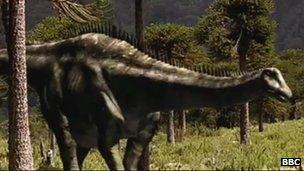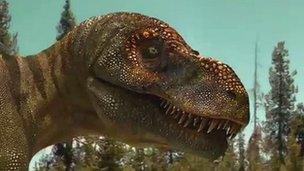Dinosaur teeth reveal feeding habits
- Published

Diplodocus' peg-like teeth were constantly replaced
Teeth from sauropod dinosaurs - the largest land animals that ever lived - reveal the feeding habits of these giants.
Researchers report that Diplodocus' teeth were replaced as often as once a month throughout the dinosaur's life.
In contrast, the teeth of Camarasaurus, another sauropod, show less frequent replacement, but bulkier growth.
This suggests that Diplodocus fed off low-lying vegetation while Camarasaurus ate upper-canopy plants.
Michael D'Emic, from Stony Brook University, New York, and co-workers used the daily layers of dentin, laid down as the dinosaur teeth grew, to determine the working lifetime and replacement rates of these massive herbivores' teeth.
Dr D'Emic explains "A nearly 100-foot-long sauropod would have had a fresh tooth in each position about every one to two months, sometimes less." These huge plant-eaters ate enormous quantities of vegetation, and their teeth suffered heavy wear.
The results are reported in the journal PLoS ONE, external.
Dr Emily Rayfield, reader in palaeobiology at the University of Bristol, commented "Diplodocus had peg-like teeth that stuck forward and out from its long narrow jaw, while Camarasaurus had a shorter jaw with a stronger bite. Their teeth wore down as they cropped vegetation."
Dinosaurs replaced their teeth constantly throughout their life with new tooth crowns sitting deep in the jaw ready to erupt beneath each working tooth. This contrasts with mammals like us, which only replace their teeth once after birth (milk teeth and adult teeth).
The results indicate that Diplodocus and Camarasaurus had different approaches to feeding, allowing them to co-exist in the same ecosystem, with Diplodocus grazing plants at ground level and Camarasaurus taking the higher-lying vegetation.

Was T-Rex predator or scavenger, or both?
T-Rex and the one that got away
Earlier this week, a different dinosaur dental examination was described in the Proceedings of the National Academy of Sciences journal. A tooth of the carnivorous giant, Tyrannosaurus rex, found in the back bone of a duck-billed dinosaur, a type of hadrosaur, has been used to infer the eating habits of T.Rex.
The study, led by Dr David Burnham at the University of Kansas, demonstrates that the hadrosaur back bone had re-healed around the embedded T.Rex tooth, showing that it escaped from the T.Rex and continued to live for some time afterwards.
Importantly, this observation feeds into a long-standing debate over whether T.Rex was a scavenger or a predator, with the authors suggesting it supports the picture of T.Rex as a predator, and not simply a carrion scavenger.
It demonstrates once more the methods used by scientists to piece together the behaviour of ancient animals from fossil fragments.
Dr Paul Barrett, dinosaur researcher at the Natural History Museum in London, added "When we look at the ecology of living animals, we see that carnivores generally eat whatever they can get hold of.
"Hyenas, that we think of as specialist scavengers, hunt quite a bit; lions, that we think of as hunters, steal carcasses from other animals.
"There is no reason to think that T.Rex, as a big carnivore, would do anything other than it would need to, to survive at the cheapest possible cost."
- Published17 July 2013
- Published7 July 2013
- Published10 May 2013